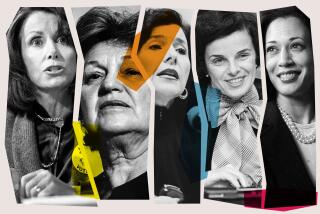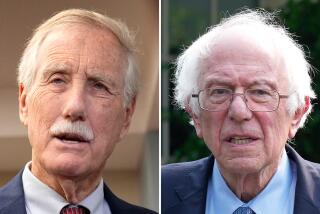Senators’ Staffs Don’t ‘Look Like America’
WASHINGTON — It was a bright, sunny January day on Capitol Hill when Barbara Boxer was sworn into office. Celebrating later with soul mate Dianne Feinstein, Boxer captured the significance of their historic campaigns.
“I have to say that today, in my opinion, the doors of the United States Senate have opened up to the people,” Boxer said. “I believe this new Senate, with more women and an African-American and a Native American, finally is beginning to look like America.”
In the ensuing months, however, Boxer and Feinstein largely have followed the traditional hiring practices within the staid institution they promised to shake up. Indeed, the predominantly white faces seated behind the desks of their Washington offices look a lot more like Iowa than ethnically diverse California.
*
After their election last fall, Boxer and Feinstein were inundated with thousands of resumes from applicants who yearned to work for two of the Senate’s rising, dynamic stars. Boxer rehired many of the aides who had toiled in her House office over the past decade and on her California campaign. Feinstein hired mostly newcomers, preferring to recruit aides with Washington experience.
The results were strikingly similar: No minority candidates were selected to fill the top dozen paid administrative and legislative positions in Feinstein’s Washington office; only one minority is among the top 12 paid staffers in Boxer’s. With a few exceptions, the minority employees on both legislative staffs serve as receptionists, clerks and mail room workers.
In Boxer’s Washington office, 31--or 70%--of the 44 employees are white, nine are black, three are Latino and one is Asian-American. A Feinstein spokesman said that 33--or 77%--of the senator’s 43 staffers are white, six are black, three are Asian-American and one is Latino.
Minority leaders say they find these numbers distressing.
“Feinstein and Boxer ought to have their staff reflective of the diversity of California,” said Zeke Hernandez, California director of the League of United Latin American Citizens. “If they have a commitment to including Latinos and minorities to their staff, they will do it. If there is no commitment, they will find excuses. And excuses won’t do.”
*
Boxer and Feinstein maintain that they have assembled a racially diverse staff.
“I want to get the best, most competent, most idealistic people on my staff,” Boxer said. “In doing that, I want them to be as diverse as the state. That is the goal. I think we’re doing pretty well on that score.”
Overall, 43% of California’s population is minority, according to 1990 census figures. One in four Californians is Latino and one in 10 is Asian-American. Some estimates project that nonwhites will become the majority in California by 2000.
To calculate the racial makeup of their staffs, both senators included their California field offices, which primarily serve the needs of constituents. When both staffs are combined, 36% of Boxer’s staff and 35% of Feinstein’s is minority. Feinstein’s California director and highest-paid employee is Kam Kuwata, a third-generation Japanese-American.
But the senators spend more than three-fourths of their time in Washington, and important policy and legislation is hammered out here. “Washington is where the power is,” said Arturo Vargas, of the Mexican American Legal Defense and Educational Fund in Los Angeles. “Any employees for the senators know that they are much more influential on policy issues if they work in Washington.”
Boxer rejects that view, saying she regards her California staff as even more important than her Washington office. She says she does not feel compelled to improve her staff’s diversity in Washington.
Feinstein said she hopes to create an upper-level position in Washington soon if she finds the right minority candidate. “I am happy to send the signal that I want to build a bank of qualified people who would be interested in working in this Senate office who are minority.”
*
On her first day in the Senate, Boxer articulated the importance of bringing diversity to the conservative body.
The Senate needs “the whole range of perspectives as it goes about its business,” Boxer said. “And in order to be a representative institution and find creative solutions to the problems, you need everyone around the table not to look like everyone else. We’ve had enough of that.”
The California senators appear to be doing better than most of their colleagues. A study in 1991 found that 89% of Washington staffers in the Senate were white.
But another freshman, Carol Moseley-Braun (D-Ill.), the Senate’s only African-American, has hired a staff of 14 whites and 14 minorities, including a black chief of staff, a black press secretary and four minority legislative assistants--two African-Americans, an Asian-American and a Latino.
More to Read
Get the L.A. Times Politics newsletter
Deeply reported insights into legislation, politics and policy from Sacramento, Washington and beyond. In your inbox three times per week.
You may occasionally receive promotional content from the Los Angeles Times.










